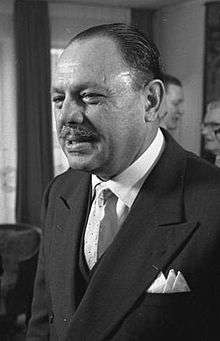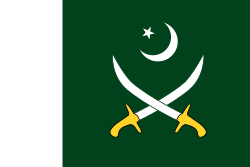Punjab Regiment (Pakistan)
The Punjab Regiment is an infantry regiment of the Pakistan Army. The modern regiment was formed in 1956 from an amalgamation of the 1st Punjab Regiment, 14th Punjab Regiment, 15th Punjab Regiment and 16th Punjab Regiment. Since then the regiment has expanded in strength to now include 74 battalions.
| Punjab Regiment | |
|---|---|
| Active | 1759–Present |
| Country |
|
| Branch | |
| Type | Light Infantry, Line Infantry |
| Size | 74 Battalions |
| Regimental Centre | Mardan, Khyber Pakhtunkhwa |
| Nickname(s) | Punjabis |
| Anniversaries | Defence Day |
| Engagements | Seven Years' War First Anglo-Mysore War Second Anglo-Mysore War Third Anglo-Mysore War Fourth Anglo-Mysore War Second Anglo-Maratha War Travancore War Anglo–Nepalese War Third Anglo-Maratha War First Burma War Coorg War First Anglo-Afghan War First Anglo-Chinese War Indian Rebellion of 1857 Bhutan War 1868 Expedition to Abyssinia Second Anglo-Afghan War Anglo-Egyptian War Boxer Rebellion Somaliland Campaign Chinese Revolution of 1911 World War I Third Anglo-Afghan War World War II Indo-Pakistani War of 1947 Indo-Pakistani War of 1965 Indo-Pakistani War of 1971 Siachen Conflict Kargil War War in North-West Pakistan |
| Commanders | |
| Colonel-in-Chief | General Khalid Shameem Wynne |
| Colonel Commandant | Lieutenant General Shahid Baig Mirza |
| Notable commanders | General Ayub Khan Muhammad Zia-ul-Haq |
It is the senior-most regiment in the Army, tracing its lineage back over two hundred and fifty years to 1751.[1] The regiment's battalions have a distinguished record of military service spanning the rise and decline of British power in South Asia, both World Wars and post independence Pakistan.
Early history
The Punjab Regiment can trace its origins to the Madras Army of the British East India Company. The most senior battalion of the 1st Punjab Regiment was raised in 1759 as the 3rd Battalion of Coast Sepoys, and is the senior most surviving infantry battalion of the British Indian Army. Their first major conflict was a decisive victory at Battle of Wandiwash in 1760, when the British East India Company led by Sir Eyre Coote effectively ended French colonial ambitions in South Asia. All the battalions of the regiment subsequently played an important role in the early military campaigns of the East India Company and were actively engaged in the wars against the French, Mysore and the Marathas.[2]
The numbers and titles of the battalions changed during the successive reorganisations of the Madras Presidency Army, the British Indian Army and the Indian Army during the 18th, 19th and 20th Centuries. The names changed from Coast Sepoys to Carnatic Infantry, Madras Native Infantry, Punjabis and finally to the Punjab Regiment. After 1857, the British applied the Martial Races theory and north Indian troops replaced the South Indians, the regiment eventually being renamed as The Punjab Regiment. It now has 76 battalions.
British Raj
Following 1857 and the establishment of crown rule over British India, the Punjab regiment played a role in numerous conflicts across the British Empire. Various battalions were deployed across the Empire in conflicts in places ranging from China, Egypt, Burma and Abyssinia.
Between 1903 and 1922, the British Indian Army included 28 numbered Punjabi Regiments. In 1922 these were amalgamated into six numbered Punjab Regiments, namely;
- 1st Punjab Regiment
- 2nd Punjab Regiment
- 8th Punjab Regiment
- 14th Punjab Regiment
- 15th Punjab Regiment
- 16th Punjab Regiment
These regiments would all play a prominent role during World War II. Within the 14th Punjab Regiment, the 1st and 5th battalions were deployed in Malaya during the opening stages of the World War II in South East Asia. The 1st Battalion, under Lt Col James Fitzpatrick, was overrun by superior Japanese forces at Changlun during the Battle of Jitra. With only 270 survivors, the 1st Battalion was not reformed during the campaign. The 5th Battalion, under the command of Lt Col Cyril Stokes, performed relatively well in the fighting retreat to Kroh in early December 1941. Stokes was killed during the Battle of Muar in January 1942. The 5/14th Punjabs was forced to surrender along with the rest of the commonwealth troops when Singapore fell on 15 February 1942. A number of troops from both battalions however later joined the Indian National Army, and formed a part of the Hindustan Field Force of the first INA.
Independence
_by_A_C_Lovett.jpg)
In 1947 the British Government announced the independence of British India, which would be split into two separate countries, India and Pakistan. The Indian Army would also be divided between these two new nation states. Out of the six existing Punjab regiments, the 1st Punjab, 8th Punjab Regiment, 14th Punjab, 15th Punjab Regiment and 16th Punjab were allotted to the Pakistan Army and 2nd Punjab Regiment to the Indian Army.
The Punjab Regiment in its present form was formed in 1956 when four of the five Punjab Regiments allocated to Pakistan were merged.
Punjabi Regiments allocated to Pakistan now forming the Punjab Regiment
- 1st Punjab Regiment
- 8th Punjab Regiment - Amalgamated with *10th Baluch Regiment and Bahawalpur Regiment to form the Baloch Regiment
- 14th Punjab Regiment
- 15th Punjab Regiment
- 16th Punjab Regiment
The line up for the new regiment was:[1]
- 1 Punjab – 1/1st Punjab
- 2 Punjab – 2/1st Punjab
- 3 Punjab – 3/1st Punjab
- 4 Punjab – 5/1st Punjab
- 5 Punjab – 1/14th Punjab
- 6 Punjab – 2/14th Punjab (Duke of Cambridge's Own)
- 7 Punjab – 3/14th Punjab
- 8 Punjab – 4/14th Punjab
- 9 Punjab – 1/15th Punjab
- 10 Punjab – 2/15th Punjab
- 11 Punjab – 3/15th Punjab
- 12 Punjab – 4/15th Punjab
- 13 Punjab – 1/16th Punjab
- 14 Punjab – 2/16th Punjab
- 15 Punjab – 3/16th Punjab
- 16 Punjab – 5/14th Punjab (Pathans)
- 17 Punjab – 4/16th Punjab (Bhopal)
- 18 Punjab – 7/1st Punjab
- 19 Punjab – 7/16th Punjab
- 20 Punjab – 14/1st Punjab
Punjabi Regiments allocated to India now forming the Punjab Regiment
1st Punjab regimental center was located at Jhelum. In early September 1947 Pakistani personnel arrived from 2nd Punjab regimental center Meerut and Indian personnel (Sikhs) were dispatched to 11 Sikh RC and Rajputs to 6 Rajputana Rifle Center.
The Punjab Regiment at its height totalled 58 battalions; however, 11 were transferred in 1980 to the Sindh Regiment.
Class and religious composition
Before 1947, the ethnic composition of the Punjabi Regiment consisted of Punjabi Muslims 50%; Sikhs 10%; Punjabi Hindu 40%. After 1947, the regiment was around 20% Pashtun and 80% Punjabi.
Modern regiment
Presently the Punjab Regiment is the largest regiment of the Pakistan Army with 47 battalions. They range from Mechanized Infantry to Light Anti-Tank (LAT) battalions. The Punjab Regimental Centre is located in Mardan, Khyber Pakhtunkhwa. The current Colonel Commandant of the regiment is Lieutenant General Majid Ehsan.
Since the creation of Pakistan in 1947, the Punjab Regiment has seen the appointment of four Colonel-in-Chiefs;
- Field Marshal Ayub Khan, 5 Punjab
- General Asif Nawaz, 5 Punjab
- General Aziz Khan[3]
- General Khalid Shameem Wynne[4], 20 Punjab
Recipients of the Nishan-e-Haider
The Nishan-e-Haider (Sign Of the Lion) is the highest gallantry award awarded by Pakistan for those showing an incredible amount of valor and courage on the battle field in the face of staunch adversity. Only ten soldiers have been awarded this honour, and four of those belonged to the Punjab Regiment:
- Captain Muhammad Sarwar Shaheed,2 Punjab(1910 – July 27, 1948)
- Major Tufail Muhammad Shaheed, 13 Punjab(1914 – August 7, 1958)
- Major Raja Aziz Bhatti Shaheed, 17 Punjab (1928 – September 10, 1965)
- Lance Naik Muhammad Mahfuz Shaheed, 15 Punjab(1944 – December 17, 1971)
As a form of respect, deceased recipients are given the honorary title of Shaheed, which means martyr, whilst living recipients are termed Ghazi which means victor.
Notable former personnel

- Field Marshal Ayub Khan Tareen, N.Pk., H.aPk., HJ - 5 Punjab
- General Asif Nawaz Janjua - 5 Punjab
- General Muhammad Shariff - 3 Punjab
- General Aziz Khan, NI(M), SBt, HI(M)
- General Khalid Shameem Wynne, NI(M) - 20 Punjab
- Col. S.G. Mehdi M.C, ex-Group Commander SSG; - 15 Punjab
- Major Malik Munawar Khan Awan, SJ, King of Rajouri (reposted to 21 AK regt from 5punjab).
- Lieutenant General KM Azhar Khan, HI, HI(M)] - 18 Punjab, The Desert Hawks Battalion]
- Lieutenant General Arif Hayat, [HI(M)] - 18 Punjab, The Desert Hawks Battalion]
- Lieutenant General Asif Yasin Malik, HI, HI(M)
- Lieutenant General Aftab Ahmad Khan
- lieutenant General M.Arif Bangash
- Lieutenant General Humayoun Khan Bangash
- Lieutenant General Tariq Pervez Khan, Escaped from Fathergarh (India) - 6 Punjab
- Lieutenant General Masood Aslam, HI, HI(M), SJ
- Lieutenant General Amir Abdullah Khan Niazi, HJ& Bar, MC 2 Punjab & 5 Punjab
- Major General Adam Khan[MC] 2 Punjab
- Major General Sher Ali Khan Pataudi, HJ 1st Punjab
- Major General Tahir Masood Bhutta, 54 Punjab
- Major General [[Abid Ejaz Kahlon, [HI(M)] - 18 Punjab, The Desert Hawks Battalion]
- Major General Haroon sikandar Pasha, 20 Punjab
- Lieutenant General Asim Saleem Bajwa, Sbt - 34 Punjab
- Major General Muhammad Mushtaq, HI, HI(M)
- Brigadier Nusrat Khan Sial, [Sitara - e - Basalat], S(Bt) - 35 Punjab
- Lieutenant Colonel Ghulam Hussain Chaudry, HJ - 3 Punjab
- Major [Farook Adam],SJ - 2 Punjab
- Major Raja Nadir Pervez, SJ & Bar - 6 Punjab
- Major Tufail Mohammad Shaheed, NH - 13 Punjab
- Major Raja Aziz Bhatti Shaheed, NH - 17 Punjab
- Captain Muhammad Sarwar Shaheed, NH - 2 Punjab
- Captain Ishar Singh, VC, OBI - 12 Punjab (28th Punjabis)
- Lieutenant Karamjeet Singh Judge, VC 12 Punjab (4/15th Punjab)
- Jemadar Abdul Latif Khan Tarin,[5] IDSM, 82nd Punjabis.
- Lance Naik Muhammad Mahfuz Shaheed, NH - 15 Punjab
- Lance Naik Sher Shah, VC - 19 Punjab
- Naik Gian Singh, VC
- Naik Shahamad Khan, VC, 89th Punjabis.
- Captain Raja Khawar Shahab Shaheed, 35 Punjab.
- Captain Abdul Jalil Orakzai Shaheed 3rd Punjab Regiment at Kali-dhar AJK 1965 War
Alliances





See also
Notes
- Rizvi, Brig SHA. (1984). Veteran Campaigners – A History of the Punjab Regiment 1759–1981. Lahore: Wajidalis.
- Qureshi, Maj MI. (1958). The First Punjabis: History of the First Punjab Regiment, 1759–1956. Aldershot: Gale & Polden.
- "Army can defend every inch: Musharraf" Archived 2008-06-11 at the Wayback Machine Daily Times, March 22, 2003
- "General Khalid Shameem Wynne promoted to Col-in-Chief : AsiaNet-Pakistan". asianetpakistan.com. Archived from the original on 14 January 2012. Retrieved 7 May 2018.
- Younger brother of Khan Abdul Majid Khan Tarin, Khan-Sahib, OBE
Further reading
- Brig. Syed Haider Abbas Rizvi (Ret.) (1984). Veteran campaigners: a history of the Punjab Regiment, 1759–1981 (Pakistan Army). Lahore: Wajidalis. A comprehensive and detailed history of the Punjab Regiment.

